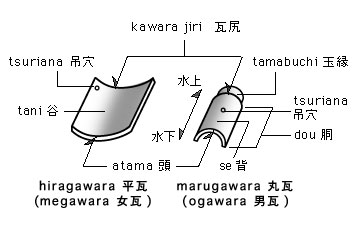|
|
| |
| marugawara 丸瓦 |
 |
 |
 |
 |
| KEY WORD : architecture
/ roofing tiles |
 |
| |
| Also
written 円瓦. Also called *ogawara
男瓦, especially in the 6c-12c. Also called tsutsugawara 筒瓦 (pipe-shaped
tile), or hanmaru tsutsugawara 半丸筒瓦 (half-cylindrical pipe-shaped tile).
Semi-cylindrical roof tiles having a pronounced convex curve. The end of the tile
that points toward the ridge has a lip *tamabuchi
玉縁 over which the front of the next tile fits snugly. These tiles are set over
the seams of the broad concave tiles *hiragawara
平瓦. Rainwater flows over them into the concave tiles where it drains along the
downward slope of the roof and runs off, minimizing problems of leakage. The length
of the visible part of the half-cylindrical tile does not vary. Because it is
slightly longer than the broad concave tile, fewer semi-cylindrical tiles need
to be used. The measurements of all roof tiles differ according to type and period
of production. Ordinary sized tiles are sometimes called namimarugawara
並丸瓦, and small tiles are called komarugawara 小丸瓦 or itomarugawara
糸丸瓦. Depending on shape, they are called cane-handle shaped tiles *tonemarugawara
利根丸瓦 or tsubamarugawara 鍔丸瓦. |
| |
| |
|
 |
 |
| REFERENCES: |
| *gyougibuki
gawara 行基葺瓦, *sangawarabuki
桟瓦葺, *fukiashi
葺足, *hongawarabuki
本瓦葺. |
 |
 |
 |
| EXTERNAL LINKS: |
| |
 |
 |
 |
| NOTES: |
|
|
 |
 |
 |
(C)2001 Japanese Architecture and Art Net Users System. No reproduction
or republication without written permission.
掲載のテキスト・写真・イラストなど、全てのコンテンツの無断複製・転載を禁じます。 |
| |

